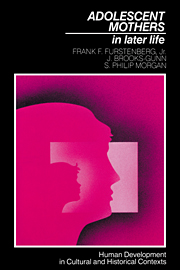Book contents
- Frontmatter
- Contents
- List of tables and figures
- Preface
- 1 Reassessing adolescent parenthood
- 2 Experience in adulthood
- 3 Pathways to success in adulthood
- 4 The children's experience
- 5 The intersecting life courses of adolescent mothers and their children
- 6 The life course of adolescent mothers: implications for public policy
- Appendixes
- Bibliography
- Index
1 - Reassessing adolescent parenthood
Published online by Cambridge University Press: 04 August 2010
- Frontmatter
- Contents
- List of tables and figures
- Preface
- 1 Reassessing adolescent parenthood
- 2 Experience in adulthood
- 3 Pathways to success in adulthood
- 4 The children's experience
- 5 The intersecting life courses of adolescent mothers and their children
- 6 The life course of adolescent mothers: implications for public policy
- Appendixes
- Bibliography
- Index
Summary
The emergence of teenage childbearing as a social problem
Unlike most of Western Europe, where family formation traditionally occurred at older ages, teenage childbearing has never been uncommon in the United States (Wattenberg, 1976, p. 54). However, not until the middle of the twentieth century did a substantial proportion of teenagers ever marry and have children. At the height of the baby boom, close to half of all women wed in their teens, and well over a quarter of all women had their first birth before age 20 (Cherlin, 1981). Curiously, in the 1950s, the prevalence of early parenthood hardly received public notice, and it certainly escaped public opprobrium when it was far more common than today.
By the following, decade, adolescent pregnancy and childbearing seemed to emerge suddenly as a social problem. Teenage pregnancy first appears in 1970 as a distinct category in the Reader's Guide to Periodical Literature, marking its cultural debut as a public issue. By the early 1980s, teenage pregnancy was “the problem that hasn't gone away” (Alan Guttmacher Institute, 1981). And in 1985, a pregnant teenager appeared on the cover of Time.
At the root of this shift in public attitudes is a series of longstanding demographic changes dating back to the end of the baby boom, when adult fertility rates began their dramatic plunge. As Table 1.1 shows, the adolescent birthrate also declines consistently across recent decades, though it was more gradual than for older women.
- Type
- Chapter
- Information
- Adolescent Mothers in Later Life , pp. 1 - 20Publisher: Cambridge University PressPrint publication year: 1987



